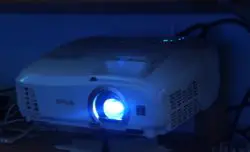Introduction
While I was creating an article on projectors with built-in speakers, I noticed some reviews mentioned an “over splash” effect for some projectors. When I did a search on Google, there was practically no useful information on this! The one review I found briefly mentioned it and once I understand what the person was talking about, I knew exactly what their problem was.
This word is just a fancy slang for something very simple. In this article, I’ll go over everything you would want to know about the projector “over splash” effect. It’s not something that should turn you away from purchasing a specific projector. It’s also important to know that a minor adjustment to your projector can easily fix this. BE sure to check out the related questions section at the bottom where I listed some other home theater terminology that’s worth knowing something about.
So what is projector over splash? As asked by many Amazon users
Projector over splash refers to the border of light created around the edges of the projected image. This effect is more commonly seen with projectors that have exceptionally circular lenses.
You can also observe projector over splash when light bleeds through the screen and creates a ghostly appearance on the edges. In some cases, the projector screen can be the reason over splash happens. Not all screens have a thick, black border around the edges and as a result, the light is poorly absorbed through the material and some people can find the light border undesirable.
If you are concerned about over splash when searching online for projectors, pay careful attention to the lens. You’ll easily be able to compare projector models and tell which ones have extremely big lenses and which ones look more practical. Older models are less consolidating and have a bulkier structure to them. Newer models are exceedingly more elegant especially when it comes to image output. This isn’t something I would be too concerned about because getting rid of over splash isn’t as hard as you would think it would be.
What to Do About It
There are three big things you can do to get rid of this effect if it really is this bad.
The first thing I would recommend doing is taking some black electrical tape and applying it to the bottom and top edges of the projector lens. You won’t need much, but applying just a little bit will discretely create a wide-screen effect to the image output. The new image created on the screen will look a lot more natural. You might think that putting tape on the top and bottom of the lens would be too obstructive, but you would only need to do this because your projector lens is too wide already.
The second thing I would recommend doing is getting a screen with a black border around it. Not all projector screens come with this, so I would make an effort to find one that does. The projector screen my family uses has Cintewhite material all around it. It’s not super fancy by any means, but it’s enough of an upgrade from our old one to where the over splash light is absorbed in the black border.
The third thing I would recommend is to call the actual projector brand company and ask for their support before your return it. More often than not, reputable brands like Epson, BenQ, and Sony, will be able to help you calibrate the projector settings. A lot of people often leave reviews on Amazon complaining about image quality, brightness, and over splash, but it doesn’t seem like they looked into adjusting their projector’s settings.
Why Do Some Projectors Create Light Bleed?
The best way to estimate the extent of any light bleed or over splash effect is to first look at the size of the lens. This was already mentioned earlier, but in all the research I did, this was the most common trait that projectors with significant over-splash possessed.
Look at keystone color corrections. Keystone color correction has to do with how the projector attempts to center the image when it is not physically centered itself. You’ll notice the image looks skewed if you try to digitally alter the projector’s image from a horizontal or vertical angle.
There’s some other technical reasons as to why you might experience this. The most useful thing you can do is reposition your projector, make the image smaller than the full length of the screen, and adjust some of the keystone color correction settings.
Related Questions
What is throw distance? Throw distance is the max range in which your projector can effectively put an image on the screen from a given distance. This will vary depending on the projector model. This is also known as throw ratio, and you can calculate this by dividing the distance by the width of the screen size. Even though the ratios vary between models, having more doesn’t mean better. Some projectors have such a short throw distance that you can put them in front of you, a few feet from below the screen. It depends on your preference and what your needs are.
What are lumens? Lumens are a measurement of how bright a projector can get. A product with a lot of lumens (greater than 2000) will be brighter than ones with lower ones. It is beneficial to invest in a projector with more lumens because those projectors will be able to better compensate for light pollution. The first project I had was super dim even in a completely dark room. If any light got into it, the image became saturated and provided an unsatisfying image on the screen. Bulb life won’t be dramatically affected by the number of lumens a projector has.
What is the difference between DLP and LCD projectors? Liquid Crystal Display projectors vary in structure from Digital Light Projector ones. LCDs are more commonly used as well as LED projectors because they provide more color spectrums and better ambient light. It all has to do with the digital micromirror devices that each one uses. Unless you’re a serious projector enthusiast who has a keen eye for profound differences in quality, you won’t really mind which type of projector you get. If you’re still in the projector buying process, I would first look at how many lumens it has, bulb life,
Conclusion
Ultimately, projector over splash isn’t something to really worry about. I have used my friend’s projectors and owned at least two within the last couple of years. Never did I once notice an over splash effect where the light was creating an annoying border around the outside of my screen. Even when I was using a sheet blanket as a screen, the bleedthrough effect didn’t actually take away from the image!
If for some reason this is something you’re thinking heavily on as you look at potential projectors, remember that there is quite a bit you can do about it and that it doesn’t have to be a total deal-breaker! Most likely, you won’t even notice this trait at all.
As always, if you have any comments feel free to reach out at entertainmentden.ns@gmail.com and I’ll do my best to respond! I’m open to any article suggestions you might have. Thanks for reading and be sure to check back for future articles!

